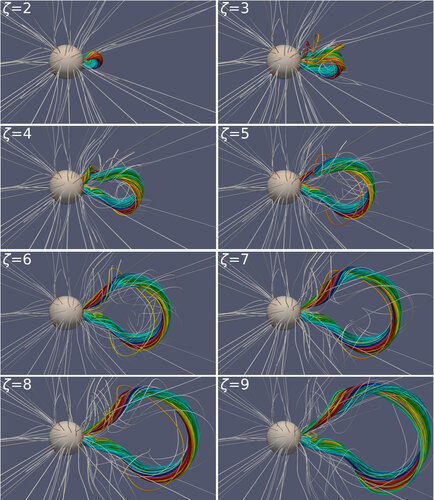The effects of space weather extend out across our entire Solar System, but this is a simulation of where everything starts: the sudden, violent, emergence of a ‘flux rope’ out of the Sun’s magnetic field and into the solar wind. In the process flux ropes may bring along millions of tons of plasma from the solar surface to be released into space, known as a Coronal Mass Ejection, CME.
This flux rope simulation was produced using one of a suite of models available via ESA’s Virtual Space Weather Modelling Centre, employed by space weather forecasters and researchers.
This simulation was made using the COCONUT coronal ‘magnetohydrodynamic’ (MHD) model – developed by a Katholieke Universiteit Leuven team and newly presented in Astronomy and Astrophysics. It simulates the initial moments of a Coronal Mass Ejection (CME) within a realistic MHD representation of the solar corona and wind derived from observed magnetograms, with results matching established CME dynamics.
CMEs are the largest eruptive processes in our Solar System. They can accelerate outwards at velocities of hundreds of kilometres per second or more. If they line up with Earth then our planet’s magnetic environment is altered in turn, potentially affecting satellites in orbit and power and communications infrastructure on the ground.
Just like terrestrial weather forecasting, the basis of space weather forecasting is to ingest observation data into detailed software models. The challenge in the case of space weather is that the models have to cover the entire Solar System, starting – as seen here – just above the Sun’s surface, into the wider heliosphere and covering CMEs and interactions with the magnetic field of Earth (and other planets).
“These are all different models with different physics and different data going in and out of these models,” explains ESA space environment and effects engineer Gregoire Deprez. “The goal with our Virtual Space Weather Modelling Centre is to have all of them coupled together, working in a chain, accessible through a single web portal. They’re made to run and talk together, with data moving on from one through to the next. We have a whole chain of models that start from the Sun, the solar magnetosphere then propagated down to Earth or your spacecraft of interest.”
The VSWMC was originally established through ESA’s General Support Technology Programme – readying promising technologies for space and is now supported through the Agency’s Space Safety Programme's Space Weather Office.
This work has been funded by KU Leuven, Belspo, the EU’s H2020 EUHFORIA 2.0 project and ESA via GSTP (ESA Contract No. 4000133080/20/NL/CRS) which explored integration of full MHD coronal models in which a flux rope CME can be embedded along with other heliospheric modelling.



 Image:
Where space weather starts
Image:
Where space weather starts